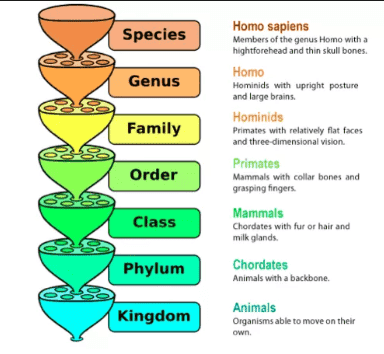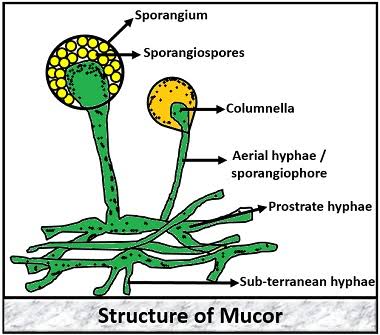MARCHANTIA - CLASSIFICATION, STRUCTURE OF THE GAMETOPHYTE, REPRODUCTION, SPOROPHYTE
A.CLASSIFICATION
Divisions-Bryophyta
Class-Hepaticopsida
Order-Marchantiales
Family-Marchantiaceae
Genus-Marchantia
The genus Marchantia comprises of 65 species and it is widely distributed in all over the world. The genus is mainly confined to temprate regions, and is found to grow in moist, cool and shady places.
About 11 species of Marchantia have been reported from India mainly growing in Himalayas and very few species occur in plains and hills. Of these the common species are - M.palmata, M.polymorpha etc
B.STRUCTURE OF THE GAMETOPHYTE
1. EXTERNAL STRUCTURE- The plant body of Marchantia is thallus-like , prostrate, flat , dorsiventrally differentiated and richly dichotomously branched. The Apex of each branched is notched. The thallus is deep green in colour and is provided with midrib. On the dorsal surface along the midrib, there appear a cup-like structure called Gemma cup. It appear when the thallus attains maturity. Mature thallus also bears certain specialized sex organs, i.e., antherediophore and archegoniophore which bears in them Anthredia (male sex organs) and Archegonia ( female sex organs) respectively.
The ventral (lower) surface of the thallus bears numerous Multicellular hair or scales, and unicellular rhizoids of two types, smooth wall rhizoids and tuberculate rhizoids. Rhizoids attach the thallus to the substratum and absorb water and solutes from the soil.
 |
| Source Wikipedia |
2.INTERNAL STRUCTURE- Internally the thallus of Marchantia shows various types of tissue differentiation-
(a) Epidermal region- It consists of well defined upper and lower Epidermis. The upper Epidermis forms a surface layer of photosynthetic regions and consists of thin walled cells with slightly thickended outer wall. The Epidermal cell contain few chloroplast. Embedded in the Epidermis are special chimney like or barrel shaped air pores.
(b) Photosynthetic region- Beneath the upper Epidermis are the air chamber in a single horizontal layer. The chamber are bounded by a one cell layer thick partition. The partition are 3-4 cells in height. Each chamber communicate with exterior through a barrel shaped or chimney like pore. From the floor of each chamber arise short, simple or branched filaments of green cells, known as assimilatry or photosynthetic filaments. The cell of photosynthetic filaments contain numerous ovoid chloroplasts.
(c) Storage region- Just below the photosynthetic regions lies the storage regions. It is thickest in the centre and traperd towards the margin. It consists of a uniform tissue made up of relatively large, colourless , thin wall polygonal, parenchymatous cell. The cell of this region lack chloroplasts but contain starch and protein grains. Isolated cell may contain a single large oil body or may be filled with mucillage. The former are called body oil cell and later muccilage cells.
The lowermost region of the storage regions is composed of Cell similiar to those of the upper Epidermis. It is the lower Epidermis. From it projects, project rhizoids and scale.
 |
| Source Wikipedia |
C. REPRODUCTION
The thallus of Marchantia is reproduce by both Vagetative and sexual process of Reproduction--
1. Vagetative Reproduction- Vagetative Reproduction takes place by following process-
(a) Fragmentation- It depends on the ageing of the Vagetative cells. The cells in the older portion die of old age and eventually disorganize. When the dead and decay of the older portion portion of the thallus raches the dichotomy, the young lobes become separated. Each of these by apical growth grows into a new thallus.
(b) Adventious branches- This may develop from any part of the thallus particularly the ventral surface. In Marchantia palmata the development of adventiius branches from the stalk and disc of the female Gametophore was reported. They become detached from the parent thallus by the decay of the connecting tissue and form a new plant.
(c) Gemmae Formation- Marchantia also reproduce by formation of Multicellular bodies called the gemma. Gemmae are produced in large number with in a small cup-like Structure called Gemma cup borne on the dorsal surface of the Gametophyte along with midrib. Each Gemma after detachment from the Gemma cup germinates into a new plant under favourable condition.
2.SEXUAL REPRODUCTION-
Marchantia is hetrothallic, i.e., dioecious. In female plant, the archegonia are borne on special erect , stalked branch called archegoniophore, similiarly in male plants the Anthredia are borne on erect, stalked branch called antherediophore.
(a) Archegoniophore- Each archegoniophore arise from a region just behind the Apex of the thallus, the mature archegoniophore consists of a long stalk bearing at its Apex a distinct , generally 8 rayed or lobed stellate disc. Between the Ray's, group of archegonia are arranged in radial rows, each row being borne in inverted position.
Each archegonium is flask shaped Structure consists of a narrow neck with several neck canal cells and swollen venter containing a ventral canal cell and an egg.
Each archegonium is attached by a short stalk to the lobe of the disc.
(b) Anthrediophore- Each Anthrediophore- is similiar in position to the archegoniophore. It consists of a stalk bearing at it apex a disc with generally 8-lobed margin. Towards the upper part of the disc Anthredia occur in flask shaped cavities.
Each mature anthredium is a pear- shaped or globular body with a short stalk , and a jacket layer of thin walled cells. Within the anthredial jacket lies numerous androcyte mother cells. Each androcyte mother cell divides diagonally form two triangular androcyte (anthrezoids mother cells). Ultimately, each androcyte is metamorphosed into biflagellate sperms i.e., anthrezoids.
 |
| Source Wikipedia |
D.FERTILIZATION
It takes place in presence of water. Generally anthrezoids from the top of the archegoniophore discs are splashed by rain water on to the slightly elevated archegoniophore above the thallus. The anthrezoids then swim in moisture and ultimately reach the egg. On reaching the egg, one sperm fuses with the egg to complete the fertilization.
As a result of fertilization, a diploid zygote 2n is formed. With the formation of zygote , diploid sporophytic generation begins.












0 Comments
If you have any query let me know.